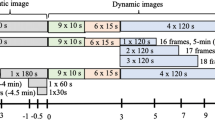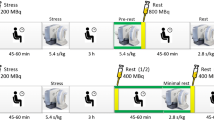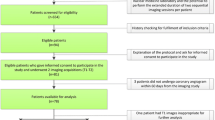Abstract
Introduction
Myocardial perfusion imaging (MPI) protocols have not changed significantly despite advances in instrumentation and software. We compared an early post-injection, stress-first SPECT protocol to standard delayed imaging.
Methods
95 patients referred for SPECT MPI were imaged upright and supine on a Spectrum Dynamics D-SPECT CZT system with CT attenuation correction. Patients received injection of 99mTc tetrofosmin at peak of regadenoson stress and were imaged. Early post-stress (mean 17 ± 2 minutes) and Standard 1-h delay (mean 61 ± 13 min). Three blinded readers evaluated images for overall interpretation, perceived need for rest imaging, image quality, and reader confidence. Laboratory efficiency was also evaluated.
Results
Blinded readers had the same response for the need for rest in 77.9% of studies. Studies also had the same interpretation in 89.5% of studies. Reader confidence was high (86.0% (Early) and 90.3% (Standard p = 0.52. Image quality was good or excellent in 87.4% Early vs 96.8% Standard (p = 0.09). Time between patient check-in and end of stress imaging was 104 ± (Standard) to 60 ± 18 minutes (Early) (p < 0.001).
Conclusion
Early post-injection stress-only imaging using CZT SPECT/CT appears promising with Tc-99m tetrofosmin with similar image quality, reader confidence, diagnosis, and need for a rest scan.





Similar content being viewed by others
Abbreviations
- AC:
-
Attenuation correction
- ASNC:
-
American Society of Nuclear Cardiology
- CAD:
-
Coronary artery disease
- CCTA:
-
Coronary computed tomographic angiography
- CT:
-
Computed tomography
- CZT:
-
Cadmium zinc telluride
- GI:
-
Gastrointestinal
- IAEA:
-
International Atomic Energy Agency
- PET:
-
Positron emission tomography
- ROI:
-
Region of interest
- SCCT:
-
Society of Cardiac Computed Tomography
- SNMMI:
-
Society of Nuclear Medicine and Molecular Imaging
- SPECT:
-
Single photon emission computed tomography
- 99mTc:
-
Technetium-99m
References
Skali H, Murthy VL, Al-Mallah MH, et al. Guidance and best practices for nuclear cardiology laboratories during the coronavirus disease 2019 (COVID-19) pandemic: an information statement from ASNC and SNMMI. J Nucl Cardiol 2020;27:1022‐9.
Thompson RC, Phillips LM, Dilsizian V, et al. Update on guidance and best practices for nuclear cardiology laboratories during the coronavirus disease 2019 (COVID-19) pandemic: emphasis on transition to chronic endemic state. An information statement from ASNC, IAEA, and SNMMI. J Nucl Cardiol 2022;29:1‐6.
Skali H, Murthy VL, Paez D, et al. Guidance and best practices for reestablishment of non-emergent care in nuclear cardiology laboratories during the coronavirus disease 2019 (COVID-19) pandemic: an information statement from ASNC, IAEA, and SNMMI: endorsed by the Infectious Diseases Society of America. J Nucl Cardiol 2020;27:1855‐62.
Skulstad H, Cosyns B, Popescu BA, et al. COVID-19 pandemic and cardiac imaging: EACVI recommendations on precautions, indications, prioritization, and protection for patients and healthcare personnel. Eur Heart J 2020;21:592‐8.
Katsikis A, Theodorakos A, Kouzoumi A, Kitziri E, Georgiou E, Koutelou M. Fast myocardial perfusion imaging with (99m)Tc in challenging patients using conventional SPECT cameras. J Nucl Cardiol 2017;24:1314‐27.
Philippe L, Merino B, Blaire T, et al. Tetrofosmin early time gated post-stress single-photon emission computed tomography imaging: feasibility and potential benefits. J Nucl Cardiol 2011;18:62‐72.
Albutaihi I, van der Veen L, Scholte A, Stokkel MP. The effects of early and late scanning on image quality and functional parameters in myocardial perfusion imaging. Clin Nucl Med 2010;35:764‐9.
Mann A, Ahlberg AW, White MP, et al. Effect of time on liver clearance of technetium-99m-tetrofosmin in patients with acute chest pain: when should imaging begin? J Nucl Med Technol 1998;26:186‐90.
Pirich C, Keinrath P, Rettenbacher L et al. 99mTc tetrofosmin myocardial perfusion scintigraphy in CAD. Performance with early and standard delayed acquisition and fractional flow reserve. Nuklearmedizin 2014;53:111-6.
Duvall WL, Case J, Lundbye J, Cerqueira M. Efficiency of tetrofosmin versus sestamibi achieved through shorter injection-to-imaging times: a systematic review of the literature. J Nucl Cardiol 2021;28:1381‐94.
Acampa W, Cuocolo A, Sullo P, et al. Direct comparison of technetium 99m-sestamibi and technetium 99m-tetrofosmin cardiac single photon emission computed tomography in patients with coronary artery disease. J Nucl Cardiol 1998;5:265‐74.
Hurwitz GA, McLaughlin DS, Slomka PJ. Comparing the image quality of myocardial perfusion agents in the clinical laboratory: small test groups and large reference populations. Nucl Med Commun 2000;21:907‐15.
Henzlova MJ, Duvall WL, Einstein AJ, Travin MI, Verberne HJ. ASNC imaging guidelines for SPECT nuclear cardiology procedures: Stress, protocols, and tracers. J Nucl Cardiol 2016;23:606‐39.
Camoni L, Santos A, Attard M, et al. Best practice for the nuclear medicine technologist in CT-based attenuation correction and calcium score for nuclear cardiology. Eur J Hybrid Imaging 2020;4:11.
Gambhir SS, Berman DS, Ziffer J, et al. A novel high-sensitivity rapid-acquisition single-photon cardiac imaging camera. J Nucl Med 2009;50:635‐43.
Gwet KL. Computing inter-rater reliability and its variance in the presence of high agreement. Br J Math Stat Psychol 2008;61:29‐48.
Delgado R, Tibau XA. Why Cohen’s Kappa should be avoided as performance measure in classification. PLoS ONE 2019;14:e0222916.
Mathur S, Heller GV, Bateman TM, et al. Clinical value of stress-only Tc-99m SPECT imaging: importance of attenuation correction. J Nucl Cardiol 2013;20:27‐37.
Ben-Haim S, Almukhailed O, Neill J, et al. Clinical value of supine and upright myocardial perfusion imaging in obese patients using the D-SPECT camera. J Nucl Cardiol 2014;21:478‐85.
Bateman TM, Heller GV, McGhie AI, et al. Multicenter investigation comparing a highly efficient half-time stress-only attenuation correction approach against standard rest-stress Tc-99m SPECT imaging. J Nucl Cardiol 2009;16:726‐35.
Depuey EG, Mahmarian JJ, Miller TD, et al. Patient-centered imaging. J Nucl Cardiol 2012;19:185‐215.
Schepis T, Gaemperli O, Koepfli P, et al. Use of coronary calcium score scans from stand-alone multislice computed tomography for attenuation correction of myocardial perfusion SPECT. Eur J Nucl Med Mol Imaging 2007;34:11‐9.
Yang J, Shi L, Wang R, et al. Direct attenuation correction using deep learning for cardiac SPECT: a feasibility study. J Nucl Med 2021;62:1645‐52.
Berker Y, Li Y. Attenuation correction in emission tomography using the emission data—a review. Med Phys 2016;43:807‐32.
Desmonts C, Bouthiba MA, Enilorac B, Nganoa C, Agostini D, Aide N. Evaluation of a new multipurpose whole-body CzT-based camera: comparison with a dual-head Anger camera and first clinical images. EJNMMI Phys. 2020;7:18.
Author information
Authors and Affiliations
Corresponding author
Additional information
Publisher's Note
Springer Nature remains neutral with regard to jurisdictional claims in published maps and institutional affiliations.
Please include the standard Springer ESM text in the note/footer on the first article page: “The authors of this article have provided a PowerPoint file, available for download at SpringerLink, which summarises the contents of the paper and is free for re-use at meetings and presentations. Search for the article DOI on SpringerLink.com.
The authors have also provided an audio summary of the article, which is available to download as ESM, or to listen to via the JNC/ASNC Podcast.
Supplementary Information
Below is the link to the electronic supplementary material.
Rights and permissions
Springer Nature or its licensor (e.g. a society or other partner) holds exclusive rights to this article under a publishing agreement with the author(s) or other rightsholder(s); author self-archiving of the accepted manuscript version of this article is solely governed by the terms of such publishing agreement and applicable law.
About this article
Cite this article
Case, J.A., Courter, S.A., McGhie, A. et al. Accurate and efficient rapid acquisition early post-injection stress-first CZT SPECT myocardial perfusion imaging with tetrofosmin and attenuation correction. J. Nucl. Cardiol. 30, 2644–2654 (2023). https://doi.org/10.1007/s12350-023-03336-x
Received:
Accepted:
Published:
Issue Date:
DOI: https://doi.org/10.1007/s12350-023-03336-x




